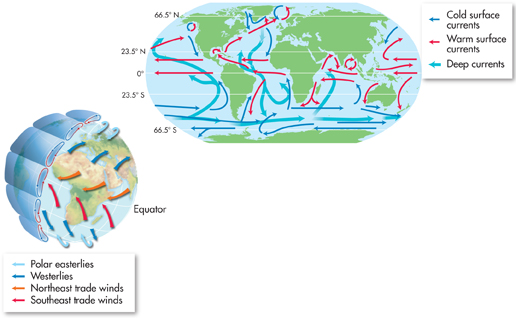Heat Transport in the Biosphere The unequal distribution of heat across the globe creates wind and ocean currents, which transport heat and moisture. Earth has winds because warm air is less dense and rises, and cool air is more dense and sinks. For this reason, air that is heated by a warm area of Earth's surface—such as air near the equator, for example—rises. As this warm air rises, it expands and spreads north and south, losing heat along the way. As it cools, the air sinks. At the same time, in cooler regions, near the poles, chilled air sinks toward Earth's surface, pushing air at the surface outward. This air warms as it travels over the surface. And as the air warms, it rises. These upward and downward movements of air create winds, as shown in Figure 4–3 (below left). Winds transport heat from regions of rising warmer air to regions of sinking cooler air. Earth's rotation causes winds to blow generally from west to east over the temperate zones and from east to west over the tropics and the poles.
Similar patterns of heating and cooling occur in the oceans. Surface water is pushed by winds. These ocean currents transport enormous amounts of heat. Warm surface currents add moisture and heat to air that passes over them. Cool surface currents cool air that passes over them. In this way, surface currents affect the weather and climate of nearby landmasses. Deep ocean currents are caused by cold water near the poles sinking and flowing along the ocean floor. This water rises in warmer regions through a process called upwelling.

FIGURE 4–3 Winds and Currents Earth's winds (above left) and ocean currents (above right) interact to help produce climate patterns. The paths of winds and currents are the result of heating and cooling, Earth's rotation, and geographic features. Interpret Visuals In what direction do cold currents in the Northern Hemisphere generally move?
d4.1 Assessment

-
Review What is climate?
Compare and Contrast How are climate and weather different?
Infer Based on Figure 4–3, which do you think has a cooler climate: the east or west coast of southern Africa? Why?
-
Review What are the main factors that determine climate?
Relate Cause and Effect Explain what would likely happen to global climate if there was a dramatic decrease in greenhouse gases trapped in the atmosphere.
ANALYZING DATA
Research average monthly precipitation (in mm) and temperature (in °C) for Quito, Ecuador, a city on the equator. Create a bar graph for the precipitation data. Plot the temperature data in a line graph.

Table of Contents
- Formulas and Equations
- Applying Formulas and Equations
- Mean, Median, and Mode
- Estimation
- Using Measurements in Calculations
- Effects of Measurement Errors
- Accuracy
- Precision
- Comparing Accuracy and Precision
- Significant Figures
- Calculating With Significant Figures
- Scientific Notation
- Calculating With Scientific Notation
- Dimensional Analysis
- Applying Dimensional Analysis




